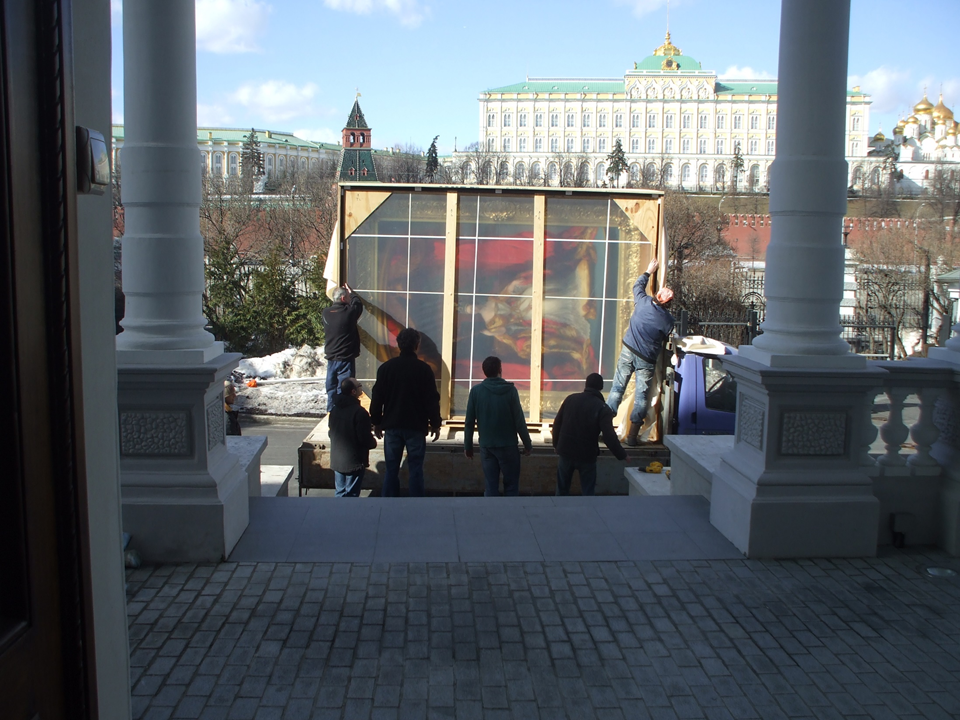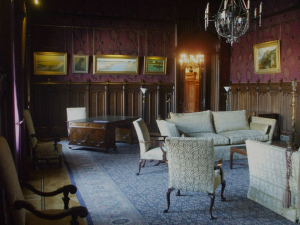There’s No Such Word as Impossible: Placing Art on Any Wall
Collection staff install works in historic buildings all over the world. This makes every hang a unique, and sometimes colourful, experience. In 2010, tasked with installing artworks throughout the Ambassador’s Residence in Moscow, our Technical Manager talks about some of the challenges this presented.

George Hayter’s Victoria being uncrated at entrance of residence in Moscow, 2010 © Crown Copyright
With over two decades of experience of installing displays for the Government Art Collection around the world, Chris Christophorou reflects on one of his more memorable projects…

Gothic drawing room in British Ambassador’s residence, Moscow, 2010 © Crown Copyright
‘The residence is a 19th century building with a dark Gothic interior that used to be a mansion belonging to a sugar-beet millionaire – it’s right opposite the Kremlin’.
This rather dramatic setting came with numerous practical challenges: It wasn’t just about hanging pictures on the wall… In this case it started with sourcing a picture rail and then installing it in the residence. We often use picture rails as a hanging solution in historical buildings where we are not allowed to drill directly into the wall. The picture rail has to be cut to size before transport and installation, which means that the precise positioning of the pictures has to be planned months in advance of the install.
The building’s interior was so dark, that each work had to have a bespoke picture light, to be seen at all – something we’d never used before. The wiring for each light was discreetly hidden by running it through the inside of the picture rail and and at precise intervals, corresponding to a picture’s position on the wall, the wire would drop down through a hole drilled into the rail to supply each picture light. Of course, this meant we had to know exactly where each picture was going to hang, to be able to drill the corresponding hole in the right place in the rail. The facilities managers at the Residence used a sonar-like laser to scan the full surface area of each wall, and provided precise architectural drawings of the walls. We then played around with scaled down miniature pictures of each work by arranging them on the architectural drawings to achieve a harmonious display – this was months before we even got to Moscow.
Installations abroad are always a slightly strange experience. You become embedded in a Residence’s life during the stay. You eat your breakfast with Ambassadors and get to see faraway parts of the world, but as if through the gaps in a fence. You end up bonding over the London neighbourhood of Tufnell Park with the Ambassador’s wife in La Paz. Somewhere else you do your morning commute aboard a tuk tuk with your spirit level and drill. But at the end of the day, your focus is ‘How am I going to hang this 80kg artwork on a one centimetre-depth of plasterboard?’

Carrying George Hayter’s Victoria up the staircase in Moscow, 2010 © Crown Copyright
Protecting the fibre of the building was at the forefront of everyone’s mind. This needed a strict discipline and meticulous attention to detail, right down to the exact placement of brackets on the wall. You have to allow room for flexibility with a job like this and I ended up extending my planned period of stay to three weeks to accommodate the late arrival (thanks to customs issues) of an oversized painting of Queen Victoria by Sir George Hayter. I missed my wife’s 50th birthday as a result!
The Hayter was the last artwork to go up and it weighed 100 kilos. It is probably one of the heaviest pictures in the Collection. It was supposed to be positioned in the upstairs dining room. The plan was for the painting to sit on a large metal bracket which supported its full weight. It was to be attached to the wall at its top edge using metal brackets screwed into a beautiful silk covering, backed by a timber panel. But there came another surprise: once we got up to the upper hanging point, there actually was just thin air behind the silk in spite of the fact I’d been assured there was timber there. The only possible solution was to take the picture down again and reposition the metal brackets in the hope they would correspond with whatever timber there was behind the silk. Fortunately they did. It transpired the timber behind the silk had been attached in the wrong position.

The portrait of Victoria being installed in the dining room in Moscow, 2010 © Crown Copyright
A compelling storyteller, Chris brings to life more fascinating tales about his role as Technical Manager than can be recounted here. But to share some of his poignant closing words: ‘It’s all about the human contact. To this day I remember Mohammed – one of the residence staff – from Cairo, who helped out with the installation. This was my first big international installation in 2002, and as continues to be demonstrated time and again, you’re relying on team-work, working with staff in situ, regardless of whether they have art handling experience or not’.
Edited by Dr Claire FitzGerald, Curator (Modern and Contemporary)